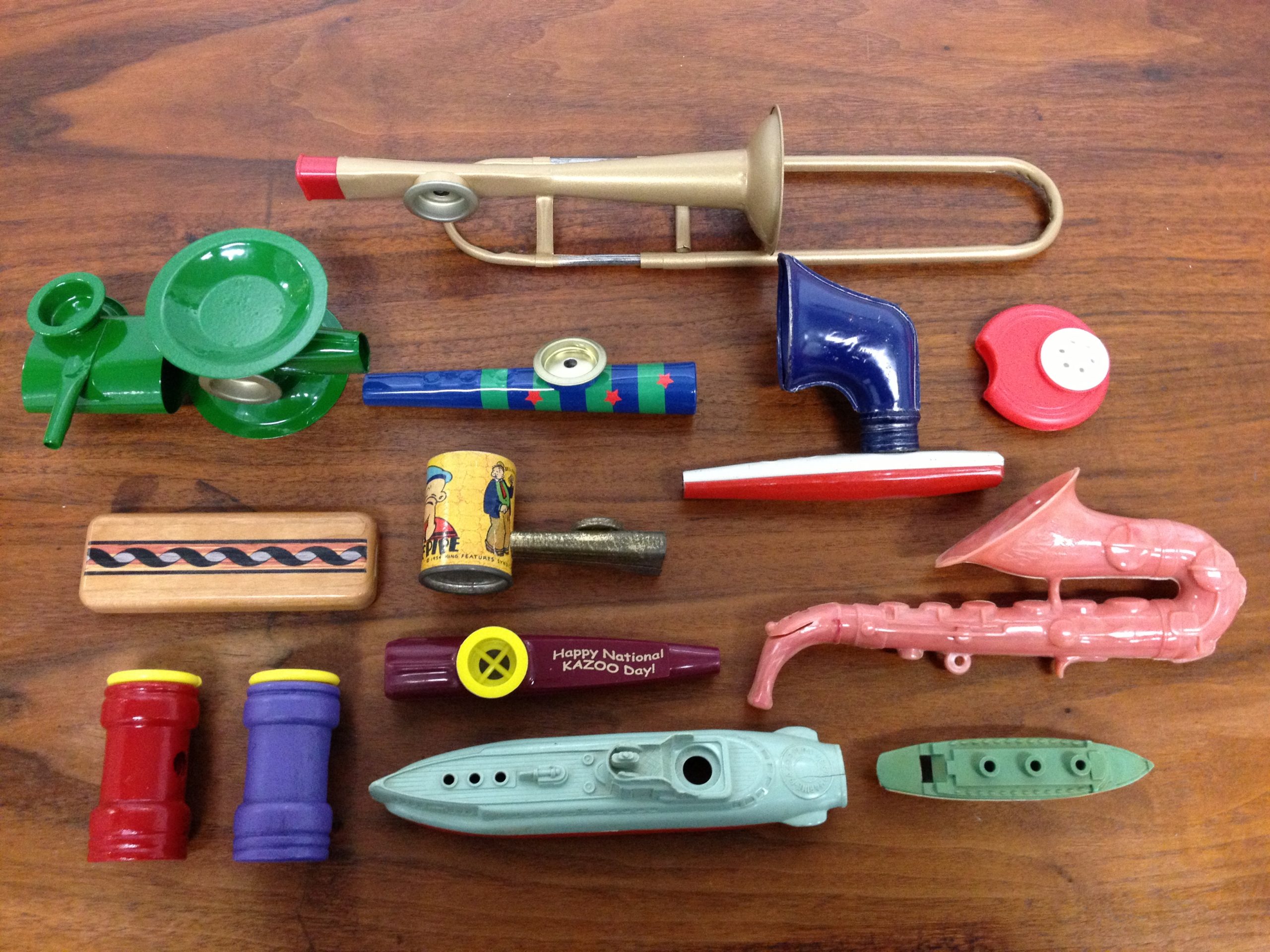“Instrument Interview” posts are a chance to sit down with the instruments of traditional, country, bluegrass, and roots music – from different types of instruments to specific ones related to artists, luthiers, and songwriters – and learn more about them. Ten questions are posed, and the instruments answer! Today we mark National Kazoo Day by talking to the kazoo!
I thought kazoos were just silly party favors, but you’re an actual musical instrument?
Well, I do have a reputation as a birthday party favor, probably to the extreme annoyance of many parents! But I am so much more than that. Kazoos are membranophones, where the tonal qualities of the instrument are produced as the player hums. I am also related to mirlitons, which are vibrating membrane instruments.
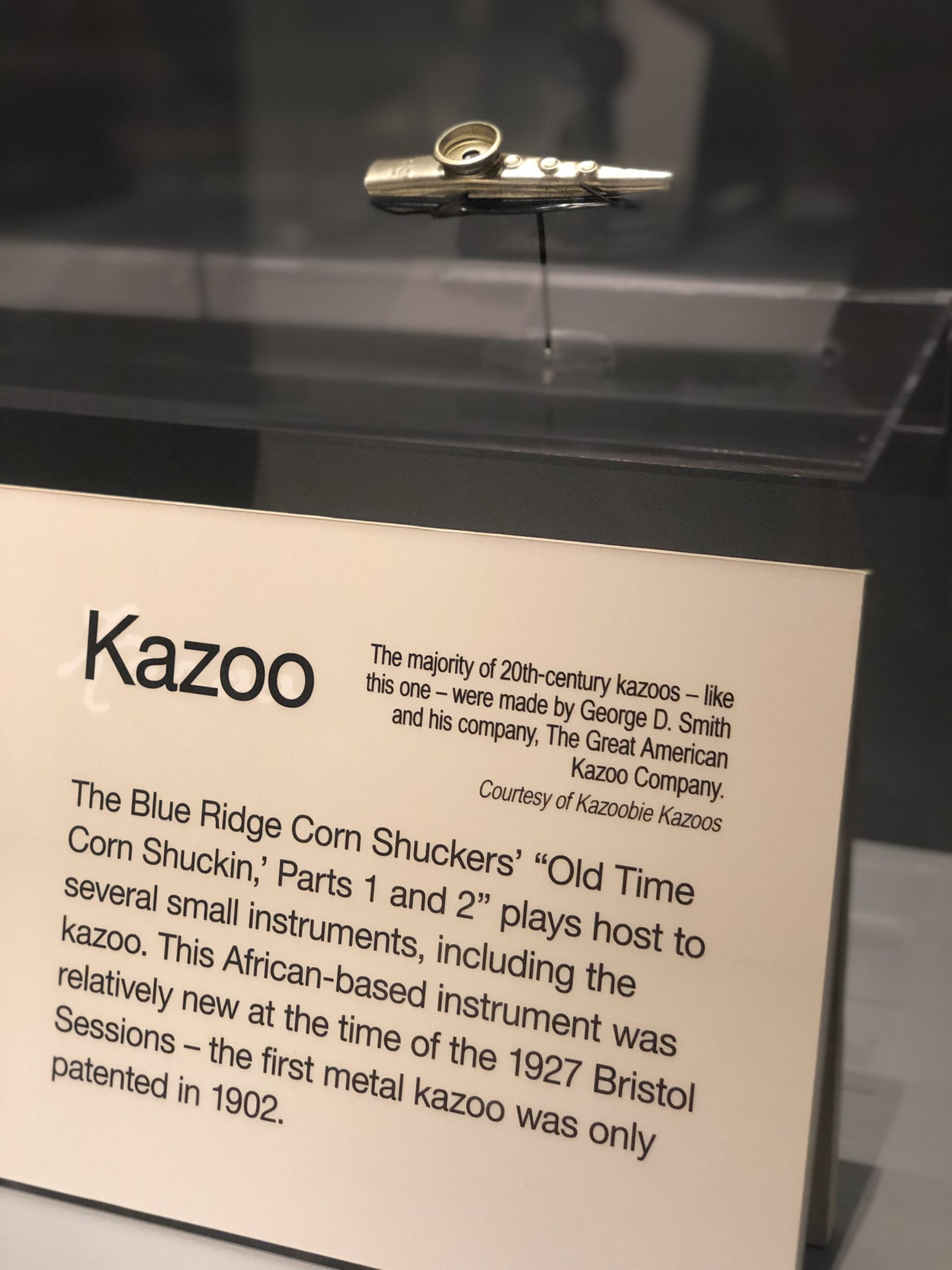
The Birthplace of Country Music Museum has a George D. Smith metal kazoo in our instrument gallery. It is on display courtesy of Kazoobie Kazoos, a plastic kazoo manufacturer in Beaufort, South Carolina. © Birthplace of Country Music
Where do you come from?
My ancestors go back to early mirlitons from Africa. They were made from cow horns or gourds, and their membranes were from spider egg silk. It must have been a tricky business to make them! These African horn-mirlitons were used for ceremonial purposes as a way to distort or mask the human voice.
Kazoo-like instruments are also known in ancient Mexico, though these looked more like recorders and the membrane was made from slivers of corn husk.
A lot of people think of the kazoo as an American instrument. How did you come about here in the States?
Different types of kazoo-like instruments, based on the African mirlitons and common in folk music, could be found in North America in the 1800s. But the kazoo as we know it is attributed to an African-American man named Alabama Vest who came up with the idea of this small instrument and then worked with Thaddeus von Glegg, a German clock manufacturer, to make his concept into reality in the 1840s.
How the kazoo went from Alabama Vest to mass production follows a couple of possible routes. The Historical Folk Toys site notes that a traveling salesman named Emil Sorg was charmed by Vest and von Glegg’s instrument, and so took the concept to create his own kazoos in New York, partnering with die-maker Michael McIntyre and starting production in 1912. McIntyre knew that to succeed, mass production was necessary and so he soon went into business with Harry Richardson, a large metal factory owner. By 1914 they were mass producing kazoos as the instrument’s popularity, and sales, skyrocketed. In 1916 their company became known as The Original American Kazoo Company, and McIntyre was awarded a patent on their kazoo in 1923. In 1994 The Original American Kazoo Company was producing 1.5 million kazoos per year! The company stayed in business until 2003, and the factory site now houses a kazoo museum.
However, the Vest-Sorg-McIntyre-Richardson kazoos were not the only ones being developed in America over this period. Another instrument – a “toy trumpet” that worked in a manner similar to the kazoo – was patented by Simon Seller in 1879. And the first instrument patented under the name “kazoo” was one created by Warren Herbert Frost – his patent was issued in 1883. However, the first metal kazoo was patented by George D. Smith in 1902.
What do you look like?
My basic shape is a tube where one end is larger and slightly flattened and the other is in the shape of a circle; both of my ends are open and uncovered. On top, I have another circular hole – known as the membrane hole – and a wax membrane can be found in the small chamber below this hole. I’ve been called “the Down South Submarine” because my shape resembles these underwater vessels.
Over the years, however, I have taken on many other shapes and forms, including being made directly in the shape of a submarine. Another example, a circa 1930 paper kazoo, was shaped like a 1920s-era microphone. Many kazoos have also been made in the shape of saxophones – Scott Paulson of the UC San Diego Library notes that “a good player could easily imitate a saxophone and create a debate: ‘kazoo or saxophone’”!
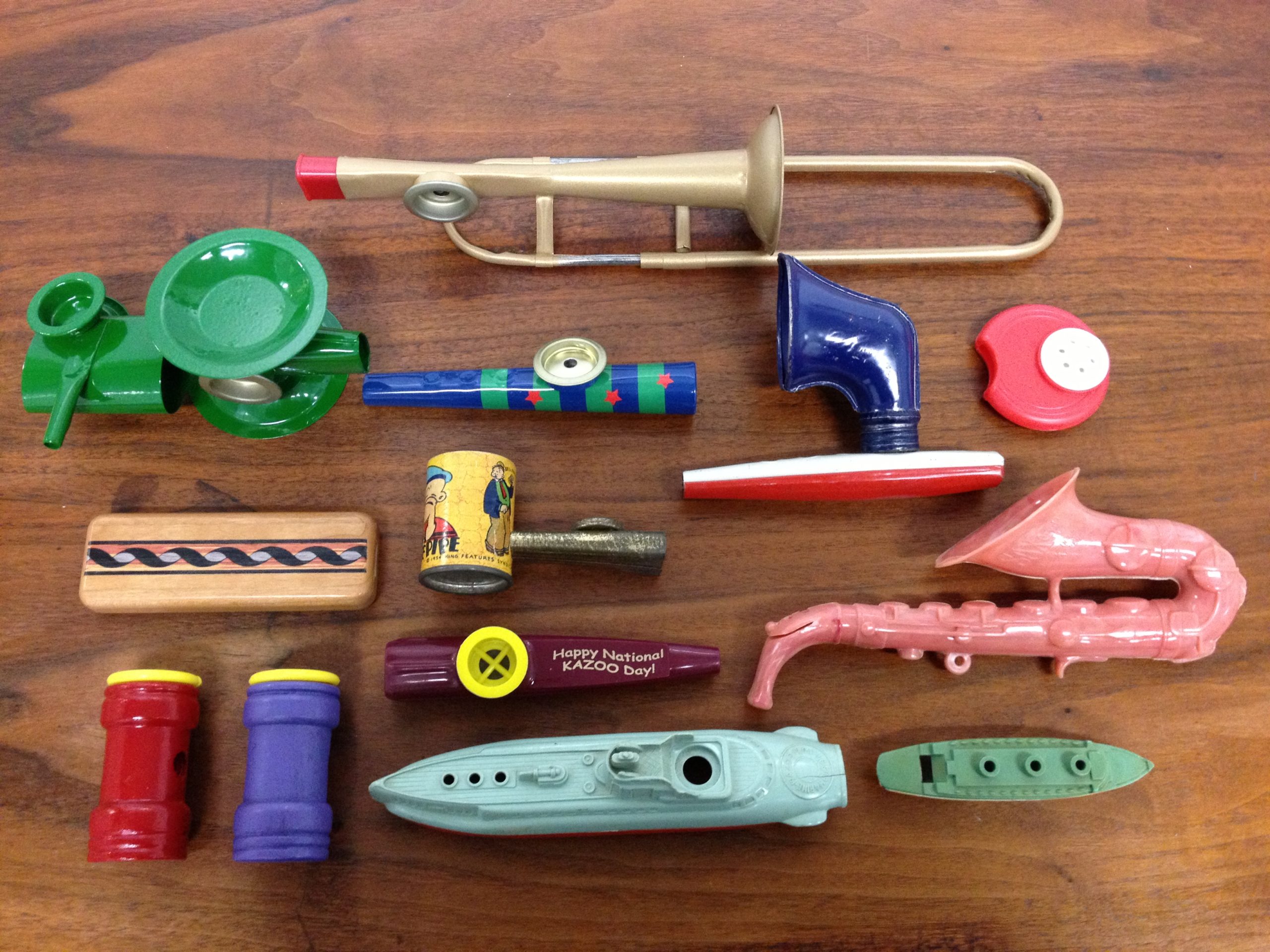
A collection of differently shaped kazoos. Courtesy UC San Diego Library
How are you played?
To play me, you should hum into the flattened opening. This makes the membrane vibrate, creating a sound that can be changed by the pitch, loudness, and nature of your humming. You can also alter the sound I make by covering the membrane hole, either in part or completely. Check out this video for a tutorial.
Many people make the mistake of blowing into me and then thinking I am broken as no sound comes out, but this will not work for creating kazoo music!
Are there any famous kazoo players or performances?
There are! Unsurpisingly you can hear the kazoo’s comic effect on Frank Zappa’s first album, Freak Out! Comb-and-paper kazoos appeared on the Beatles’ song “Lovely Rita” from the Sgt. Pepper’s Lonely Hearts Club Band album, and Sir Paul McCartney played the kazoo on the 1975 Ringo Starr single “Sweet 16.” World Wrestling Federation duo Edge and Christian often brought their kazoos into the ring, driving their foes to distraction with their playing and often winning the bout as a result. Jimi Hendrix used a comb-and-paper kazoo on his 1968 recording of “Crosstown Traffic.” Kazoos – to imitate the sound of electric razors in an executive washroom – were also used in the song “I Believe in You” in the Broadway comedy How to Succeed in Business Without Really Trying.
Some performers made a career of their kazoo playing, such as Barbara Stewart who even performed at Carnegie Hall! And some composers have written their own kazoo music – for example, Mark Bucci composed his “Kazoo Concerto,” which premiered at a Leonard Bernstein Young Peoples’ Concert with the New York Philharmonic in 1960.
I’ve named just a few, but if you look for them you can find all sorts of famous kazoo performers or performances!
Were you played at the Bristol Sessions?
I sure was! Kazoos were commonly used in jug bands and comedy songs, and that is where you will find me on the 1927 Bristol Sessions recordings. Ernest Stoneman joined together with different configurations of friends and family to record several songs for Ralph Peer in 1927. One of those configurations was made up of Stoneman, Bolen Frost, George Stoneman, Iver Edwards, Kahle Brewer, and Uncle Eck Dunford to form the Blue Ridge Cornshuckers singing “Old Time Corn Shuckin,’ Parts 1 and 2.” As the song progresses, Stoneman invites each musician to introduce himself, play a little bit, and then take a sip from the passing jug!
Even though you are a light-hearted – and fun to play – instrument, do you get used for serious purposes too?
Yes, indeed, I am sometime used in speech therapy to help strengthen oral and speech skills – for instance, kazoos can help children in the production and awareness of speech. We can also be used to help speech recovery for people who have suffered a brain injury, and to help in speech production and awareness for the deaf or hard of hearing. Kazoo use can even play a role in increasing respiration and oxygenation.
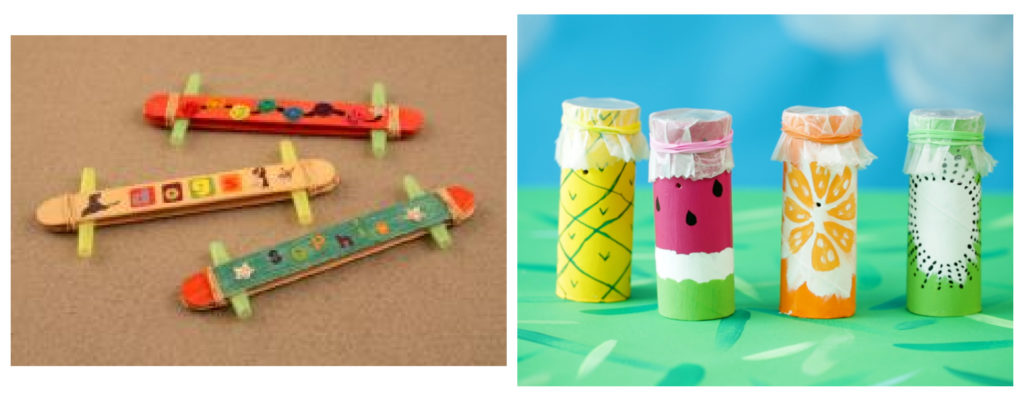
How do I make my own kazoo?
There are a few ways to make your own kazoo. You can make one using popsicle sticks, a straw, and rubber bands as seen here; using a toilet paper tube and wax paper as seen here; or the classic comb-and-paper version as seen here. Get crafting!
Anything else you want to share with us?
Special thanks to Scott Paulson of the UC San Diego Library for his help with kazoo facts and photos! The Library has hosted special events around National Kazoo Day for the past few years. Starting off from a challenge to use “serious library tools to investigate a light, playful topic,” the Library’s “kazoo salute” has included exhibits, live kazoo performances, and the commissioning of original kazoo music.
Finally, the kazoo is known as “the most democratic of all instruments” because ANYONE who can hum can play it! So give me a try!
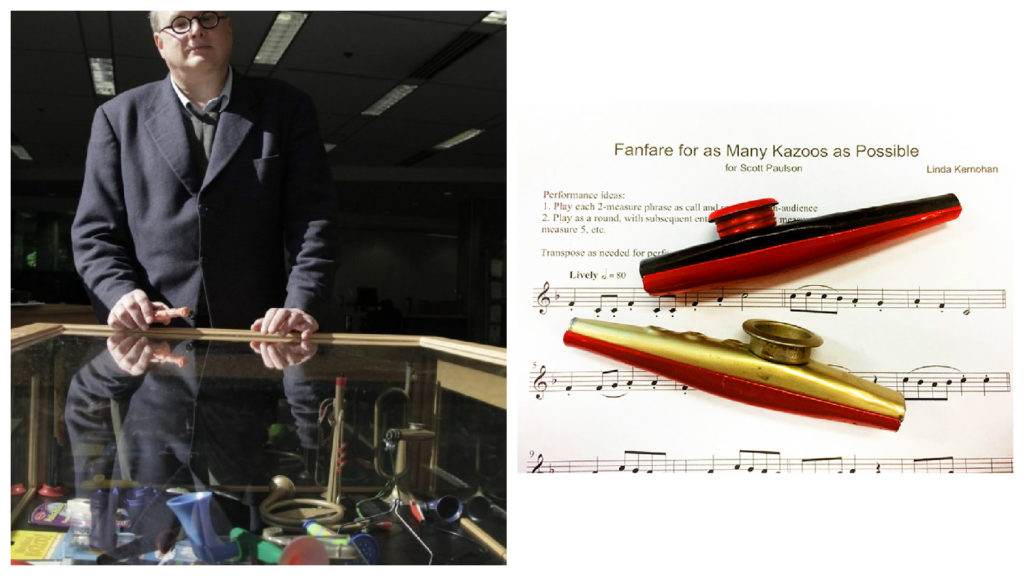
Scott Paulson with a UC San Diego Library kazoo display; “Fanfare for as Many Kazoos as Possible,” an original composition by Linda Kernohan. Courtesy UC San Diego Library


